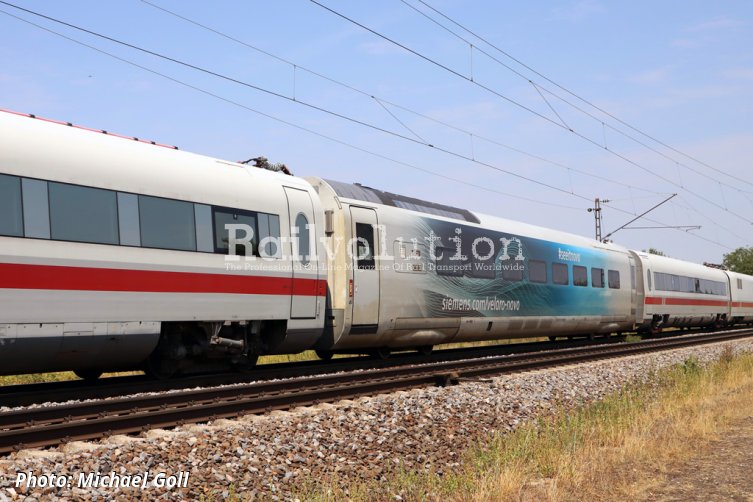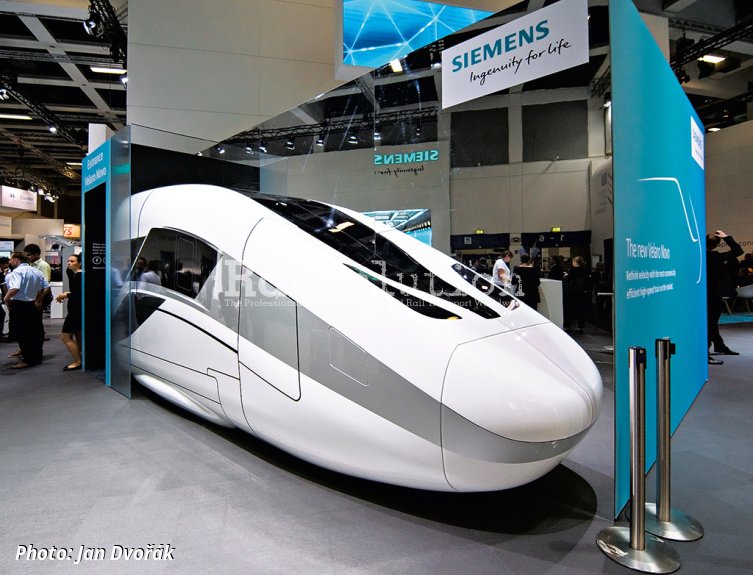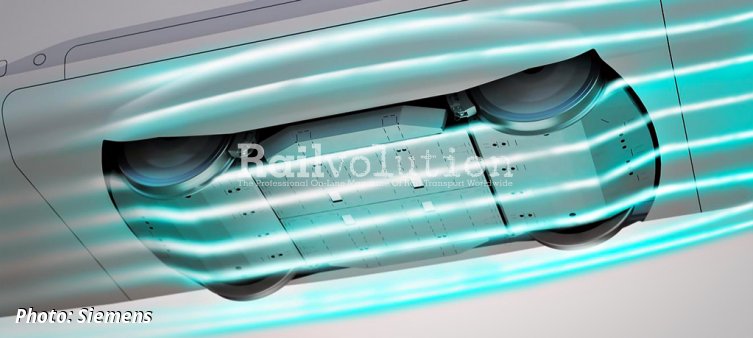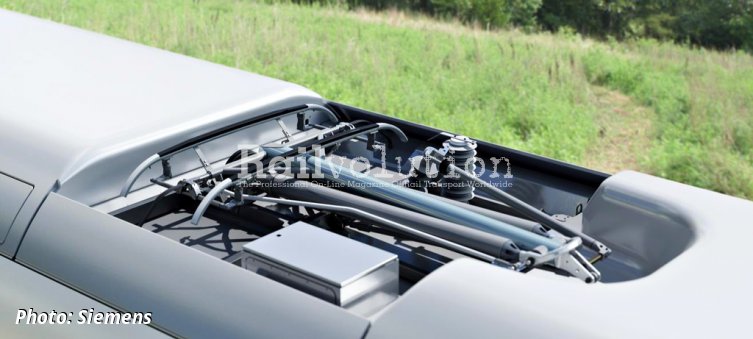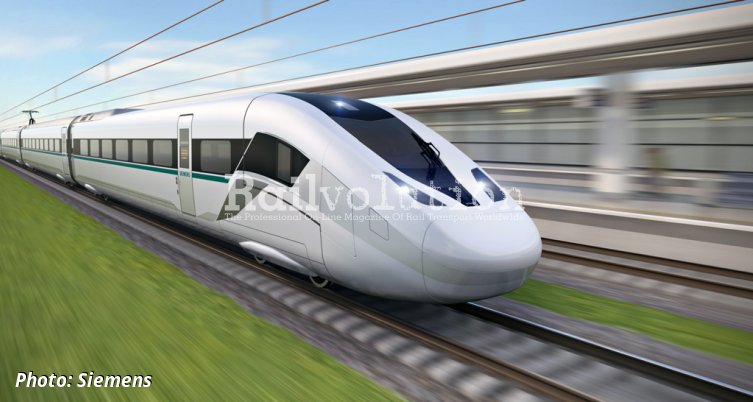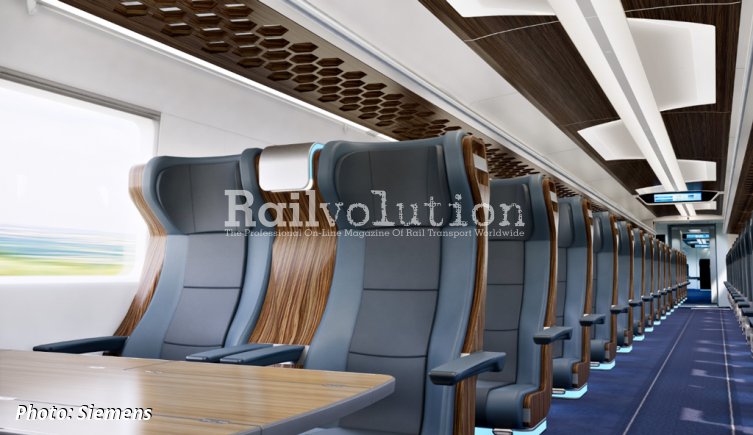Testing Of A Velaro Novo Car Continues
posted on 2nd Dec 2020 18:47
In April 2018 testing began of the Velaro Novo prototype car, which has been incorporated in DB Systemtechnik’s ICE-S test train, running throughout Germany. It is equipped with many new features, including the bodyshell, bogies, doors and windows. The bogies - one powered and one trailer bogie - were manufactured by Siemens Graz. However the motorised bogie is not yet being used for traction purposes, and is tested as if it was a non-powered bogie.
By mid-October 2018 it had covered 30,000 km. The results obtained from testing were in line with the simulations and expectations. Testing was scheduled to last for two years, with the Velaro Novo carriage covering around 100,000 km. Now, the prototype Velaro Novo car is still being tested by Siemens together with DB Systemtechnik, using the ICE-S test train.
In 2018 and 2019 priority was given to running performance tests. Siemens again stated that the results were as expected. Part of the tests in 2019 focused on the brake performance to receive the permission to operate the car without special monitoring devices at speeds of up to 300 km/h (a maximum service speed in Germany). Since July 2019 the test car is participating in regular inspection runs on the German network.
Up to now more than 100,000 km have been travelled giving information about the operational behaviour of applied technical solutions. In particular further specific test have been realised, for instance on the wear properties of a brake system. Various technical solutions, for example for covers and side skirts (made of aluminum and fiberglass reinforced plastic) have been tested, as well as first test for the pantograph started. For the future the prototype Velaro Novo car will further accompany the regular track inspection runs. Further specific tests on running performance and comfort are planned at speeds beyond 330 km/h. Also further pantograph tests are planned.
The Velaro Novo Introduction
At InnoTrans 2018 Siemens in its indoor exhibition complex presented its Velaro Novo high speed train concept, using a digital means of presentation. The exhibit took the form of a mock-up of one half of the front of an end car positioned against a large mirror, to create the appearance of a complete end car. The Velaro Novo trains will be designed with distributed traction, for top speeds in the range from 250 to 360 km/h, and is claimed to have 30 % lower energy consumption than existing Velaros.
Lightweight construction techniques will also result in a 15 % weight reduction, compared with members of the current Velaro fleet. Interior redesign will also result in a 10 % increase in the space available for passengers. A large portion of these energy and weight savings will be achieved through the use of bogies with inside bearings. These not only significantly reduce the weight compared with conventional bogies but thanks to their smaller dimensions they can also be equipped with aerodynamic covers, not only at the sides, but also underneath, thus greatly reducing the train’s aerodynamic drag. Conventional bogies with their various protruding components create aerodynamic swirls and eddy currents, which contribute considerably to drag.
One consequence of reduced aerodynamic drag is that it is not necessary to install as much traction power as with trains fitted with bogies of a conventional design. That also means a significant reduction in traction energy consumption. For example, the seven-car Velaro Novo with a top speed of 280 km/h has a continuous output of 4,700 kW only, while the 230 km/h seven-car ICE 4 has a continuous output of 4,950 kW. Moreover it is also planned to install permanent magnet synchronous traction motors.
The aforementioned 30 % reduction of energy consumption is attributable to the savings on covered bogies with inside bearings (15 %) and on aerodynamically enhanced bodyshells (10 %), as well as to the increase in traction drive efficiency (5 %). At present there are no plans to build a complete prototype train prior to a contract for a Velaro Novo being awarded by a client. Siemens states that the first Velaro Novo could be ready to enter service in 2023.
The Velaro Novo Concept
The Velaro Novo project originated in 2013 as a response to the ways in which the worldwide market demand for new high speed trains is evolving. The result was the creation of designs for a highly flexible range of trains, which can be adapted to meet the requirements of most clients, and can also be modified to meet changing needs.
The Velaro Novos will incorporate distributed traction, a system used by Siemens first in the ICE 3s, and subsequently on other Velaro versions. The trains are to be built as AC single-voltage (15 kV 16.7 Hz or 25 kV 50 Hz) or dual-voltage (15 and 25 kV AC). Siemens initially proposes two basic lengths of train: a seven-car 202 m long configuration, weighing around 420 t, and a 14-car 404 m long version, weighing around 840 t (with design-permitted payload and all seats occupied - gross laden weight). Both types will be 2,880 mm wide.
The loading gauge will enable ope-ration on most 1,435 mm gauge lines in continental Europe. However, for networks with more generous loading gauges it will be possible to produce wider bodyshells, enabling 2 + 3 seating configurations. The Velaro Novo end cars will be 28,780 mm long over couplings, while the intermediate cars will be 28,750 mm long (by way of comparison, the ICE 4 end cars are 29,106 mm long and its intermediate cars are 28,750 mm long).
Both seven- and 14-car formations are envisaged as having variable top service speeds, between 250 and 360 km/h. For example, the seven-car 280 km/h version will have a continuous power rating of 4,700 kW, a braking power using the rheostatic/recuperative electrodynamic brake of 5,600/7,200 kW and a starting tractive effort of 230 kN. The seven-car 360 km/h version will have a continuous power rating of 8,000 kW, a braking power using the rheostatic/recuperative EDB of 8,400/11,800 kW, and a starting tractive effort of 275 kN. The equivalent power rating values for a 14-car formation will be double the above figures.
The axle arrangements of the seven- and 14-car formations have not yet been revealed. It is also not exactly known whether the Velaro Novo will follow the distributed traction pattern of the ICE 3 design or the power car concept used for the ICE 4 design. The high performance electrodynamic brake will be powerful enough to bring the train to a halt from its maximum speed. The roof mounted brake resistors will be cooled by fans. Air inlets and outlets will have automatically opening flaps.
The Velaro Novo has an enhanced aerodynamic design, taking into account the fact that aerodynamic drag is one of the main contributing factors to energy consumption in high speed trains. The cab ends will be more streamlined than is the case with existing Velaros. The inter-car gangways will have sides which are flush with the bodyshell sides, thus eliminating the creation of air current eddies in these areas. This will substantially reduce overall aerodynamic drag.
At roof level, most of the high-voltage equipment is covered and, when the pantographs are lowered, they are concealed inside pockets set into the roof. This is a resultant development from the design of the latest Velaros. Siemens reckons that compared with the recent batch of the Velaros built for TCDD, the abovementioned aerodynamic features result in a 10 % energy saving.
Another area on trains creating air current eddies and hence contributing to aerodynamic drag are the bogies. For the first time on a Velaro, Siemens is to equip the Velaro Novo with skirting covering the bogies - not only will the sides of the bogies be screened, but also their bases. This is considered very difficult to achieve, since bogie components heat up considerably, especially when the brakes are applied at high speed. Siemens calculates that these measures to reduce aerodynamic drag around the bogies should result in a further 15 % reduction in energy consumption, so the efforts of research into the design will ultimately be worthwhile.
The bodyshells of the Velaro Novo will be made of aluminium, using stir welding technology. This will enable the use of aluminium sheets which are stronger, thinner and yet of more sophisticated design than those used in the past. The bodyshells will be built as „empty tubes“. In other words, there will be no obstructions, housings or casings in the interior from end to end. For instance, electrical equipment will either be housed in the space between ceiling and roof, or in the end walls of the carriage. This leaves the whole of the carriage free of obstructions, so clients can specify exactly how they want to configure the passenger accommodation.
The bodyshells will be fitted with Siemens’s radio frequency-selective window pane coatings to allow radio signals in certain frequency ranges to pass through unhindered while attenuating other frequencies, thus considerably enhancing the reception of signals for devices such as mobile phones, tablets and laptops.
The Velaro Novo’s bogies will be of the inside bearing type, essentially derived from those of Desiro City EMUs, but also incorporating and refining design experience gained with the bogies of existing Velaros. Using an inside bearing bogie results in a substantial weight reduction of both powered and trailer bogies. Compared with TCDD’s Velaro TR, bogie weight has been reduced by 25 %.
All bogies will be fitted with tread brakes, while the trailer bogies will also be equipped with axle disc brakes. In both cases these brakes will only be used in emergencies. The bogies will not be fitted with any rail brakes, but the reason for this was not mentioned. The powered bogies will be equipped with synchronous traction motors with permanent magnets. Two such traction motors have been tested on a Velaro RUS (Sapsan), these tests taking place between May 2015 and June 2016. The traction equipment will incorporate IGBT technology, the auxiliary converters using silicon carbide technology.
When running at 300 km/h the Velaro Novo will use 30 % less energy than the Velaro TR. This translates into an average saving of 1,375 t of CO2 per annum. Of this 30 % reduction, 25 % is gained through the train’s aerodynamic design, while the remaining 5 % is gained by increased efficiency and weight reduction. Thanks to the incorporation of state-of-the-art measurement and sensor technology to enable predictive maintenance and the further optimisation of the maintenance-friendly design, the maintenance costs of the Velaro Novo will be around 30 % lower than those of the Velaro TR.
Although the actual features of the passenger accommodation will be left to clients to specify, the Velaro Novo design will enable a greater passenger seating capacity to be possible without compromising comfort standards. Although the bodyshells will be narrower than those of earlier Velaros, the aisles will be 11 mm wider, though this has been achieved through the optimisation of all influencing parameters.
The First Test Carriage
One carriage of the prototype Velaro Novo already exists. This was built at Krefeld since it is impossible to test all the features of a new train using digital simulation, and „hands-on“ experience is vital before a complete passenger-carrying train is built. At Krefeld over 100 members of the workforce were involved in developing the new Velaro Novo carriage and the new train concept. The test car is an intermediate trailer of serial design, but incorporating many components of the new design, these including the bodyshell, bogies, doors and windows.
In comparison to the Velaro Novo intermediate cars the prototype one is 29,270 mm long over couplings, since the couplings fitted are slightly longer than the batch-produced ones. The distance between the bogie centres is 19,170 mm, the vehicle weighs 50 t tare and it is equipped as a laboratory vehicle. It can negotiate curves with a minimum radius of 150 m. It carries the EVN 93 80 5811 101-1 D-SIEAG.
Following initial testing on the Prüfcenter Wegberg-Wildenrath, starting in April 2018 the carriage has been used for test runs on DB Netz network. On 26 April 2018, after the initial test runs realised on conventional lines like that between Chemnitz and Tharandt, the test carriage was incorporated in the ICE-S test train for test runs on the various German high speed lines. The first high speed test runs were made between Berlin and Hannover and then on the NBS between Leipzig and Erfurt, with speeds up to 331 km/h having been reached by mid-June 2018.
Future Prospects
According to Siemens the Velaro Novo offers future clients great variability with a slightly greater range of top service speeds, between 250 and 360 km/h, while, compared with Velaro TR, up to 10 % more space can be obtained. Moreover these parameters can be achieved while simultaneously reducing both tare weight by up to 15 %, and energy consumption by as much as 30 %. It is also anticipated that maintenance costs can be reduced by 30 %, and investment costs by up to 20 %.
Siemens clearly intends the Velaro Novo to be an international-applicable train design. The Velaro Novo could thus be regarded as a possible candidate for the London to Birmingham HS2. However, the design of its bodyshells would have to be modified, since one of the requirements for the new HS2 trains is that they must also be able to run on the rest of the Network Rail system, where more restricted loading gauges than in the rest of Europe apply. As far as potential future clients are concerned, Siemens stated that „there are talks“.

